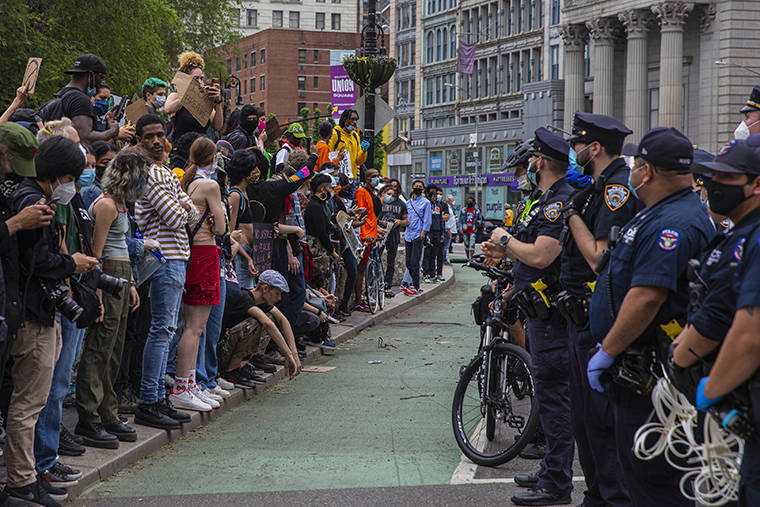National Guard called as Minneapolis erupts in solidarity for George Floyd | Honolulu Star-Advertiser

Protesters and police face each other in New York, May 28, 2020. A wave of protests erupted across the country overnight and into Thursday days after George Floyd, an African-American man, died in police custody in Minneapolis.
MINNEAPOLIS >> Minnesota’s governor activated the National Guard today as angry demonstrators took to the streets for a third straight night to protest the death of George Floyd, a black man who was pleading that he couldn’t breathe as a white police officer pressed his knee into Floyd’s neck.
The order by Gov. Tim Walz came as the city asked for help after vandalism and fires erupted during demonstrations and as the Justice Department announced that a federal investigation into Floyd’s death was a top priority.
At a news conference this evening, U.S. Attorney Erica MacDonald pledged a “robust and meticulous investigation” into the death but stopped short of announcing criminal charges against the four officers who were at the scene, all of whom were fired after Floyd’s death was captured in a haunting videotape.
“My heart goes out to George Floyd,” said MacDonald, a former judge. “My heart goes out to his family. My heart goes out to his friends. My heart goes out to the community.”
South Minneapolis continued to seethe at the treatment of Floyd — and demonstrators railed against what they described as a city in which black lives are valued less than those of white residents.
“I want justice. I hope the continued pressure will get us charges, but we have to have some patience,” said Jamar Nelson, a community activist who works with families of crime victims. “The worst outcome is if we rush and the charges don’t stick.”
In one section of Minneapolis tonight, hundreds of people held a vigil near where Floyd died, leaving new flowers and balloons not far from a mural of him, newly painted along a building’s wall. In other parts of the city and in St. Paul, police in riot gear clashed with protesters amid reports of vandalized buildings and fires in businesses and in a car. In Minneapolis, at least one person was injured in a stabbing during the chaos, the police said, though details were sparse.
Minneapolis’ deep racial divide is as much a feature of the city for its black residents as its picturesque parks, robust employment and thriving businesses.
African Americans earn one-third as much as white residents. They graduate from high school at much lower rates, are much likelier to be unemployed and tend to live in households with significantly less wealth than their white counterparts.
One university professor calls it the “Minnesota paradox” — a pleasant place belied by gaping racial inequalities.
Those disparities, the result of generations of discriminatory government policies, are now helping to fuel an uprising in the wake of Floyd’s death.
The demonstrations, which continued today, spread to other parts of the metropolitan area, and the state Capitol was evacuated as a precaution.
The case stirred protest in other parts of the country. Demonstrators turned out in Los Angeles on Wednesday night and in New York’s Union Square today. The protests in New York later moved to City Hall, where some demonstrators skirmished with the police. More than 30 people were arrested in those protests.
“George Floyd’s death represents every fight, every battle for black progress in this city,” said Mike Griffin, a longtime community organizer in Minneapolis.
“We want justice for George Floyd,” he continued, “but this is also about black dignity. We have had to fight tooth and nail for even the most basic standards of living. If you are white, this is a great city. If you are black, it is a struggle every day.”
Even as public officials urged calm today after a chaotic evening in which someone was fatally shot near the protests in Minneapolis, police officials from around the country condemned the police actions that led to Floyd’s death. It was a rare and remarkable public denunciation by law enforcement of their own.
Although Minneapolis is politically progressive and many white residents speak of racial justice, black residents say it has not been enough to solve the inequities. In fact, there is often resistance.
For several years, advocates for workers pushed the city to adopt a $15 minimum wage, which the City Council did in 2017, but only after overcoming vigorous opposition from local businesses.
“A lot of white people say they are not racist because they have black friends,” said Cynthia Montana, “but they go back to their white neighborhoods with their white friends. That’s why they don’t understand and they’re surprised when this happens.”
Montana, 57, rode her bicycle today near a Target store that had been vandalized and looted during the previous night’s unrest and reflected on the challenges of growing up as a black person in Minneapolis. It begins in school, she said, where white children who get in trouble are excused as having a bad day, while black students are deemed to have disorders that need correcting.
“It’s like layer and layer and layer of gunpowder building over a long time,” she said. “And when you become an adult, it’s this stick of dynamite.”